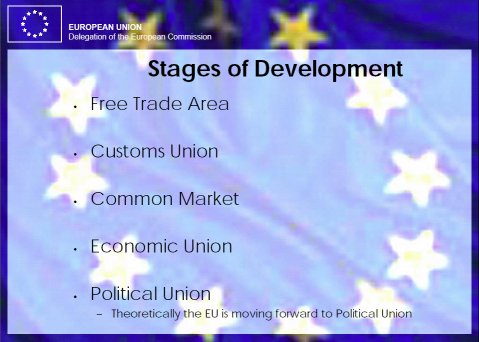Carving a Path to [North American] Regional Governance
Research By D. Niwa
A "customs union" is one in a series of steps that lead nation-participants toward establishing regional government. In its 2003 Labour Review [3], the International Labour Organization (ILO; a United Nations agency) describes such a regional entity as a "supra-national authority whose decisions are binding for member states." (p. 63)
The "supra-national authority" is the final stage after taking specific actions that are part of ła generally accepted classification system for integration" that consists "of several steps or successive phases of increasing complexity.˛ (p. 63)
The last level -- when a "supra-national"/aka regional government is set up -- is where a nation ceases to be sovereign / autonomous.
The 2003 Labour Review cites 6 levels of the economic integration process (p. 63) [emphasis added]:
Level 1:
"preferential economic areas or zones, where
trade advantages exist among the participating
countries, but without negotiations regarding key
trade aspects between the signers."
Level 2: "the free trade zone or area,
in which tariff and
non-tariff measures are usually eliminated
between member countries, although each member
maintains these restrictions when trading with
non-participating countries."
Level 3: "the customs union, which
eliminates restrictions on the circulation of
goods from member countries and
imposes a common external
tariff on imports from non-member
countries."
Level 4: "the common market, where
commodities, capital and
workers circulate freely."
[Note that on page 64 it says: "... in the common market, the free circulation of workers in all member countries is a deliberate objective, something that does not occur with free trade agreements. In Europe, which was a common market before becoming an economic union, workers circulated well before capitals and services did so." ]
Level 5: "The economic union . . .,
in addition to the aforementioned aspects,
economic policies are
harmonized in terms of targets for
inflation, fiscal deficits and
others.
In the final level: "total economic
integration establishes the unification of
monetary, fiscal, labour, social and environmental
policies with a supra-national authority
whose decisions are binding for member states."
ENDNOTES:
[I encourage everyone to go to the
sources cited below that contain info that will contribute
to one's knowledge about how a North American Union (and
Western Hemisphere Union) is being established through the
workings of international labor issues and multinational
trade agreements]
[1] June 9, 2005: Dr. Robert A Pastor (Vice President
of International Affairs, Professor, and Director of the
Center for North American Studies, American University.
Washington, D.C.) was invited by the U.S. Senate Foreign
Relations Committee (Subcommittee on the Western Hemisphere)
to give his testimony -- titled "A North American Community
Approach to Security." In his testimony, Pastor says of the
United States, Mexico, and Canada:
"The three governments should negotiate and complete within five years a North American customs union with a common external tariff (CET)." <http://www.senate.gov/~foreign/testimony/2005/PastorTestimony050609.pdf>
[2] Jan. 25, 2007: Lou
Dobbs interviewed Robert Pastor who co-chaired the CFR task
force that produced the "Building
a North America Community" report. Dobbs mentions that
CFR president Richard Haass stated:
"The Task Force's central recommendation is establishment by 2010 of a North American economic and security of community, the boundaries of which would be defined by a common external tariff and an outer security perimeter."
During the interview, Pastor
says [emphasis added]:
"I think the vision
defined in that [CFR] report is one of three
sovereign nations cooperating with each other to
deepen economic integration, to
create a common external tariff . . . "
Pastor also says during the interview: "I think we
should move towards to negotiate a customs
union. A common external tariff."
Read the full transcript: <http://transcripts.cnn.com/TRANSCRIPTS/0701/25/ldt.01.html>

[3] 2003 Labour Review, Latin America and the Caribbean, (1st edition 2003, ISBN 92-2-115256-1 (web pdf version)). Read chapter titled "Labour Aspects Associated with Integration Processes and Free Trade Agreements in the Region," pages 63-70. <http://www.oit.org.pe/portal/documentos/labour_overview_2003.pdf> Note: link no longer works but the document was captured and now resides on the channelingreality website (link above embedded in text).